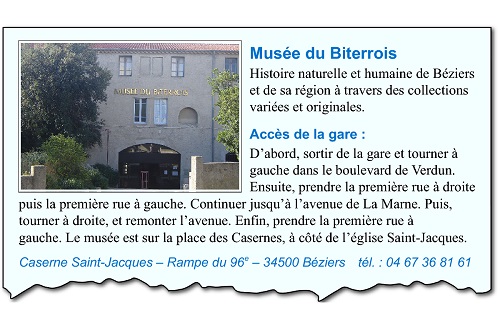5 Expressing a series of events
In this final section of the course before the end of week quiz, you will look at how to express the order in which a sequence of events or actions take place.
Activity 9
a.
True
b.
False
The correct answer is b.
Discussion
Le musée est situé sur la place des Casernes.
a.
True
b.
False
The correct answer is b.
Discussion
Le musée du Biterrois est un musée d’histoire naturelle et humaine.
a.
True
b.
False
The correct answer is b.
Discussion
C’est un musée régional.
a.
True
b.
False
The correct answer is a.
Discussion
True
Part 2
Read the text again and identify all the verbs that are used to give directions to the museum.
Discussion
You will have noticed that the verbs are all in the infinitive; in writing, the infinitive is often used to give instructions.
You should have noted: sortir; tourner; prendre; continuer; tourner; remonter; prendre.
Part 3
Read the instructions again and identify the different steps needed to get from the station to the museum. Make a list of the words that are used to mark the sequence of actions to be undertaken.
Discussion
d’abord, ensuite, puis, enfin
To describe a series of events or give a set of instructions in a particular sequence, you use a number of adverbs to indicate the order of occurrence (see Table 1).
| d’abord / tout d’abord / premièrement | first of all |
| ensuite / deuxièmement | then, secondly |
| puis (ensuite) | then, next, afterwards |
| enfin | finally, eventually |
Activity 10
Listen to the recording and put the sequence of instructions in the right order.
Transcript
Alors, d’abord prenez la rue en face, ici, ensuite tournez dans l’avenue Charles de Gaulle, et continuez tout droit, puis ensuite remontez la rue de la République et tournez à gauche au bout de la rue, enfin traversez la place du 14 Juillet et l’office de tourisme est juste derrière le théâtre.
Activity 11
Imagine you are working at the tourist office of your local town and you need to compile directions from the railway station to the town’s most popular landmark for a brochure.
Your directions should include sequencing, appropriate verbs and prepositions. You should use the infinitive for the verbs, as these are written instructions.
Discussion
Here is a model answer.
Pour aller de la gare à la salle Georges Brassens :
Alors, d’abord, sortir de la gare, aller droit devant vous dans la rue de l’Hôtel de Ville et traverser la place Charles de Gaulle. Ensuite, continuer tout droit dans l’avenue de Paris puis tourner à droite dans le boulevard Anatole France, enfin tourner à gauche dans l’avenue du 14 Juillet. La salle George Brassens est à côté de la place du 14 Juillet, près de l’office de tourisme.

